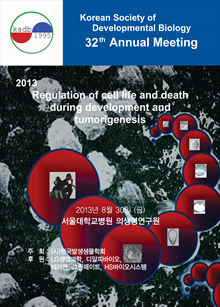간행물
한국발생생물학회 학술대회논문집

- 발행기관 한국발생생물학회
- 자료유형 학술대회
- 간기 연간
- 수록기간 1998 ~ 2017
- 주제분류 자연과학 > 생물학 자연과학 분류의 다른 간행물
- 십진분류KDC 472DDC 570
권호리스트/논문검색
한국발생생물학회 2009년도 특별 Symposium (2009년 1월) 14건
1.
2009.01
서비스 종료(열람 제한)
2.
2009.01
서비스 종료(열람 제한)
3.
2009.01
서비스 종료(열람 제한)
4.
2009.01
서비스 종료(열람 제한)
5.
2009.01
서비스 종료(열람 제한)
6.
2009.01
서비스 종료(열람 제한)
7.
2009.01
서비스 종료(열람 제한)
8.
2009.01
서비스 종료(열람 제한)
9.
2009.01
서비스 종료(열람 제한)
10.
2009.01
서비스 종료(열람 제한)
11.
2009.01
서비스 종료(열람 제한)
12.
2009.01
서비스 종료(열람 제한)
13.
2009.01
서비스 종료(열람 제한)
14.
2009.01
서비스 종료(열람 제한)
Oh H.J., Hong S.G., Park J.E., Kim M.J., Gomez M.N., Kim M.K., Kang J.T., Kim J.E., Jang G., Lee B.C.
The cloning of canids was succeeded in 2005, several years after the birth of Dolly the sheep and also after the cloning of numerous other laboratory and farm animal species. The delay of successful somatic cell nuclear transfer (SCNT)was due to the unique reproductive characteristics of the female dogin comparison to other domestic mammals, such as ovulation of immature canine oocyte and a requirement of 25 days for the completion of meiosis within the oviduct (Holst & Phemister, 1971). When the technology for the recovery of in vivo matured oocyte was established, the application of cloning also became possible and cloned dog offspring were obtained. This report summarizes the progress of technical procedures that are required for cloning canids and the application of this technique. The first cloned dog, Snuppy, was achieved using an in vivo-matured oocyte which was enucleated and transferred with an adult skin cell of male Afghan hound. After establishment of a criterion of well-matured oocyte for the improvement of SCNT efficiency, we obtained three cloned female Afghan hound and a toy poodle cloned from 14 year-old aged Poodle using SCNT through this factor. To date, cloned dogs appeared to be normal and those that have reached puberty have been confirmed to be fertile. Through application of canine SCNT technique, first, we demonstrated that SNCT is useful for conserving the breed of endangered animal from extinction through cloning of endangered gray wolves using inter-species SCNT and keeping the pure pedigree through the cloning of Sapsaree, a Korean natural monument. Secondly, we showed possibility of human disease model cloned dog and transgenic cloned dog production through cloning of red fluorescent protein expressing dog. Finally, SCNT can be used for the propagation of valuable genotypes for making elite seed stock and pet dog. In summary, dog cloning is a reproducible technique that offers the opportunity to preserve valuable genetics and a potential step towards the production of gene targeted transgenic cloned dogs for the study of human diseases.

